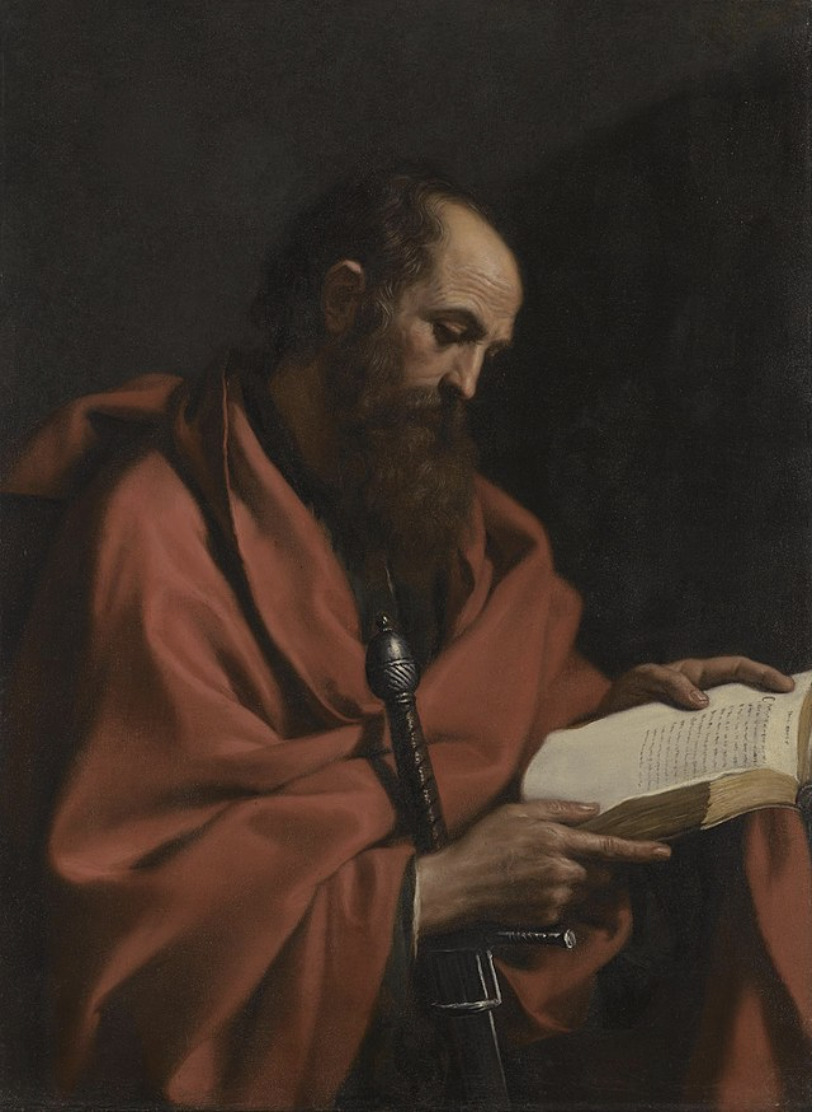In this essay, Catherine Nichols raises the question, was Paul the Apostle a radical advocate for gender equality or a defender of a binary hierarchy? By rigorously examining 1 Corinthians 11:3-12, Nichols lays out Paul’s ambiguous—and often contradictory—ideas about the position of women relative to men and God. Focusing on Paul’s specific verbiage and incorporating dissonant scholarly interpretations of these passages, Nichols determines that he is neither feminist nor chauvinist, but focused on the success of Christian churches. Moreover, Nichols’ sophisticated analysis reveals the fraught nature of theological interpretation itself and just how much room is left for negotiation.–Olivia Petty ‘26
Authority vs. Autonomy: Gender Hierarchy in 1 Corinthians 11:3-12 and the Pauline Canon
Catherine Nichols ’28

The teachings of Paul the Apostle are integral to the Christian canon, and verses from the fourteen letters attributed to Paul are common readings in Christian liturgy. Many passages of the letters known to have been written by Paul include powerful messages in favor of gender equality, and at times permit greater social mobility and church status for women than was typical at the time. However, other passages, including 1 Corinthians 11:3-12, lend themselves to a hierarchical vision of women’s status, which obscures Paul’s overall message on the status of women. Taken together, his ideas appear contradictory, spurring researchers to analyze everything from potential translation errors to the cultural and historical context of Corinth at the time Paul wrote in attempts to decipher Paul’s intent and the implications behind this passage. Although Paul did include theological statements about equality in Christ in his letters, his mission to maintain order in the developing Christian church took precedence over the establishment of gender equality, and 1 Corinthians 11:3-12 is ultimately a command that maintains binary and hierarchical laws concerning gender presentation instead of opening doors for women.
1 Corinthians 11:3-12 can be broken down into two primary messages. The first is one of instruction, in which Paul tells the Christians of Corinth how they are to wear their hair while praying. The second is one of explanation, which presents the different views of creation and gender hierarchy. The Greek word kephalē, or “head,” is used several times throughout the passage, and it carries different meanings in its various contexts. Paul’s discussion of head coverings refers to the physical heads of both men and women, but he also writes that “Christ is the head of every man, and the husband is the head of his wife, and God is the head of Christ” (1 Cor 11:3, The Holy Bible, New Revised Standard Version. I will refer to this version as NRSV). In this context, kephalē could mean many things, but the most commonly proposed meanings are “authority” or “source” (Gench 43). Interpreting “head” as “authority,” akin to how one today might describe a CEO as the “head” of a company, is a popular approach, and establishes a hierarchy of men ruling over women as Christ rules over men, whereas “source” has a more neutral connotation and draws on the Genesis creation story that Paul references a few verses later. However, Christian New Testament scholar Frances Taylor Gench notes in her chapter on 1 Corinthians 11 that the interpretations of “authority” versus “source” are not mutually exclusive (Gench 43). Indeed, man being the “source” of woman still provides space for a patriarchal view of men holding authority over women.

Even so, kephalē does not necessarily entail authority, and scholars have employed various creative interpretations to make sense of the word. Juliann Bullock, a Protestant pastor, authored an essay, “Authority to Cover Her Head: The Liberating Message of 1 Corinthians 11:3–16,” that seeks to reinterpret Paul’s use of kephalē into a word that holds men and women in equal value under God. Rather than “source” or “authority,” Bullock concludes that kephalē is best translated as the body’s “most prominent part,” though not necessarily its most important part or that which holds authority over the rest of the body (4). She goes on to describe the head as living in conjunction with the other body parts. “Within the body of Christ men and women are like two different parts of the same body. We need each other […] Men and women are different, but interdependent” (Bullock 4-5). If man is the kephalē of woman, she argues, then men and women exist as equally vital parts of a body—man is just more prominent.
While an interdependent and non-hierarchical interpretation of the word “head” may be more appealing to egalitarian readers today, it is only partially substantiated in the remainder of the passage. Paul articulates the mutual dependence of man and woman in 1 Cor 11:11-12, which reads: “Nevertheless, in the Lord woman is not independent of man or man independent of woman. For just as woman came from man, so man comes through woman; but all things come from God” (NRSV). This supports Bullock’s conclusion that Paul intended to establish equality between the genders and upholds Paul’s general theology of expanded freedoms for women. However, theologian Richard Hays points out that even if the Greek word kephalē does not clearly denote a hierarchical relationship, “in view of the whole shape of the argument, the patriarchal implications of v. 3 are undeniable” (184). Even when taking the entire content of 1 Corinthians into account, man is still placed nearer to God than woman in verse 3, as men are the head of women, but as Gench points out, “the woman is ‘head’ of nothing” (43). This need not be inherently degrading to women, as it is not insulting to the church that it has a head, but it is inherently stratified on the basis of sex, even if it does not explicitly posit an ideology of male domination over women.
In the same passages where Paul proclaims men the metaphorical “head” over women, he also pronounces a literal edict that women should cover their heads in church. This instructional portion references passages from Genesis 1-3 alongside more opaque ideology that potentially stems from Greco-Roman culture in order to explain to the Corinthian church why women should wear a head covering. Paul’s letter was likely in response to a letter he received from his church in Corinth. Richard Hays speculates that the women of church may, in accordance with Paul’s teachings about freedom in Christ, have begun to remove their head coverings and let loose their hair whilst worshiping and prophesying, and that Paul’s response is a disapproval of these actions (182-183). Gender is the defining factor of whether or not Paul deems head coverings appropriate, and he makes this decision based on the idea of “reflection” or “glory,” an idea that is puzzling when read in the greater context of the creation stories and Bible as a whole. The idea of women being the glory of man, as posited by verse 7, appears in the Bible for the first time in Paul’s writing, and is not consistent with either Genesis creation story from which Paul takes inspiration in this passage (Hays 182-183). In Genesis 1:27, it is made clear that both man and woman were created in the image of God, rather than God creating men in his image and women in the image of man.
Some scholarly interpretations of these passages seem more consistent with other stances in which Paul appears to promote gender equality, though not always successfully. Bullock proposes that the idea of women being the glory of man does not imply a hierarchical relationship, but that it is indeed a great honor for women to reflect glory onto men (5). Her line of reasoning continues in this manner, as she proposes that the creation of women from and for men is a privilege as well (6). I find this argument unpersuasive and almost laughable. Bullock deems the placement of men as closer to God to be illustrious, but in actuality, this placement makes women out to be of lesser, secondary importance. Being created for and from men, rather than alongside them is not, as Bullock claims, a privilege.
Paul takes a more tangible step towards gender equality in verse 10, where he writes “It is for this reason that a woman ought to have authority over her own head, because of the angels” (The Holy Bible, New International Version.). In some versions, including the NRSV translation, this line is instead translated as “For this reason a woman ought to have a symbol of authority on her head,” but a large scholarly consensus holds that the most accurate translation is “authority over,” which allows significantly more freedom for women to make decisions about their own bodies (NRSV). However, as Gench points out, the greater context of the passage does not give the women of Corinth as much of a choice as it may appear in verse 10. She agrees that Paul does give women authority over their own heads, but that it is authority to decide whether to wear head coverings, knowing that if they choose not to, they bring disgrace upon the men of their church and their own selves (Gench 46). The notion that women can “make their own decisions” is disingenuous—women may accept the markers of gender differentiation in church or “choose” to invite humiliation and disgrace.
The issue of head coverings itself is just as enigmatic, due largely to the fact that scholars cannot be fully certain about customs in Corinth at the time or to what prompted Paul’s letter concerning them. Though the details of Paul’s conflict with the Corinthians are not available, the greater context of 1 Corinthians may shed light on Paul’s larger goals and how 11:3-16 fits into the puzzle. As scholar Margaret Mitchell points out in her lengthy examination of Paul’s rhetoric, 1 Corinthians as a whole serves as a plea to the church in Corinth to resolve the pervasive factionalism within the community that was becoming distracted by its disagreements (Mitchell). It is possible that certain passages are attempts to compromise or soften his rhetoric, including verse 10 and verses 11-12, which support a woman’s authority over her own head and the interdependence of men and women, in spite of the messaging in other sections of the text that imply otherwise (Mitchell 262). Theologian Robin Scroggs adds that Paul’s incentive may not have stemmed from misogyny or a desire to establish or maintain a gender hierarchy, but rather to maintain gender distinction. Scroggs argues that the interdependence of men and women is not synonymous with the lack of distinction between the sexes, and that Paul sought to correct a divisive Corinthian practice by reinforcing gender distinction, a theme that appears throughout Pauline writings (289).

Ultimately, it is unlikely that Paul was either an early chauvinist or a bastion of early feminism. Although many parts of his canon advocate for the elimination of gender hierarchy and the acceptance of women taking active roles in the church, his primary mission was to establish successful Christian churches—which occasionally meant sacrificing gender equality for the purpose of maintaining order and faithful propriety. 1 Corinthians 11:3-12 is a deeply enigmatic passage, and interpreters have understood it to mean many different things, to many different ends. These verses contain theological statements on the interdependent nature of man and woman alongside gender-specific directives and stratified visions of “headship” that uphold gender hierarchy and deny women the closeness to God that Paul grants to men. However, 1 Corinthians 11:3-12 is not primarily concerned with gender relations, and exists in the context of a letter seeking to maintain unity and order in a developing Christian church that was growing unruly. For the Corinthian society, the reinforcement of binary gender roles would be an unfortunate but necessary measure in order to maintain social order and uphold gender distinctions. The tension between gender hierarchy and gender equality is not one that can or should be surmounted when reading 1 Corinthians 11:3-12. Engaging honestly with a complex—and at times contradictory—text can strengthen our understanding of these biblical passages and how they should or should not be interpreted and applied to life today.
Works Cited
Barbieri, Geovanni Francesco (1591-1666), “Saint Paul.” Painting. Wikimedia Commons, 08 July 2009.
Bullock, Juliann. “Authority to Cover Her Head: The Liberating Message of 1 Corinthians 11:3–16.” Priscilla Papers, Spring, 37, no. 3 (2023): 3–7.
Gench, Frances Taylor. Encountering God in Tyrannical Texts: Reflections on Paul, Women, and the Authority of Scripture. Louisville, KY: Westminister John Knox Press, 2015.
Hays, Richard B. First Corinthians: Interpretation: A Bible Commentary for Teaching and Preaching. Louisville, KY: Westminster/John Knox Press, 2011.
Keller, Joshua. “Gutenberg Bible on Display at the New York Public Library.” Photograph. Wikimedia Commons, 9 May 2009.
Mitchell, Margaret Mary. Paul and the Rhetoric of Reconciliation: An Exegetical Investigation of the Language and Composition of 1 Corinthians. Louisville, KY: Westminster/John Knox Press, 1993.
Scroggs, Robin. “Paul and the Eschatological Woman.” Journal of the American Academy of Religion XL, no. 3 (1972): 283–303. https://doi.org/10.1093/jaarel/xl.3.283.
The Holy Bible, New International Version. Biblica, 2011. BibleGateway.com, www.biblegateway.com/versions/New-International-Version-NIV-Bible/#booklist.
The Holy Bible, New Revised Standard Version. Oxford University Press, 1989.
Zwegers, Arian, “Guatemala City, Semana Santa Procession.” Photograph. Open Verse, Licensed under CC BY 2.0.
Recent Comments